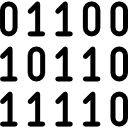Truth tables: Difference between revisions
Mr. MacKenty (talk | contribs) (Created page with "<center> <blockquote style="padding: 5px; background-color: #FFF8DC; border: solid thin gray;"> File:Exclamation.png This is an '''important concept'''. You should ful...") |
Mr. MacKenty (talk | contribs) No edit summary |
||
| Line 7: | Line 7: | ||
[[File:binary.png|frame|right|This is a basic concept in computer science]] | [[File:binary.png|frame|right|This is a basic concept in computer science]] | ||
A truth table is a mathematical table used in logic—specifically in connection with Boolean algebra, boolean functions, and propositional calculus—to compute the functional values of logical expressions on each of their functional arguments, that is, on each combination of values taken by their logical variables (Enderton, 2001). In particular, truth tables can be used to tell whether a propositional expression is true for all legitimate input values, that is, logically valid.<ref>https://en.wikipedia.org/wiki/Truth_table</ref> | |||
== Boolean== | == Boolean== | ||
Revision as of 13:02, 1 June 2016
This is an important concept. You should fully understand this.
A truth table is a mathematical table used in logic—specifically in connection with Boolean algebra, boolean functions, and propositional calculus—to compute the functional values of logical expressions on each of their functional arguments, that is, on each combination of values taken by their logical variables (Enderton, 2001). In particular, truth tables can be used to tell whether a propositional expression is true for all legitimate input values, that is, logically valid.[1]
Boolean[edit]
This is one of the better videos I've seen on boolean. Content gratefully used with permission : [2]
Truth Tables[edit]
Do you understand this topic?[edit]
Do you have an advanced understanding about this topic?[edit]
- [[2.1.11 Define the Boolean operators: AND, OR, NOT, NAND, NOR and XOR. Level 1
- [[2.1.12 Construct truth tables using the above operators. Level 3
- [[2.1.13 Construct a logic diagram using AND, OR, NOT, NAND, NOR and XOR gates. Level 3
